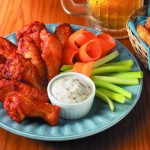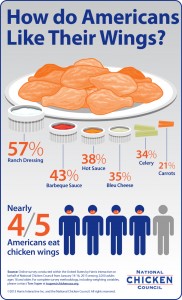Chicken wings have become a staple food of Super Bowl parties in the United States, and demand for them on menus is now at an all-time high leading up to the second biggest eating day of the year–Super Bowl Sunday.
Super Bowl weekend is unquestionably the biggest time of the year for wings. According to the National Chicken Council’s 2013 Wing Report, more than 1.23 billion wing portions will be consumed during Super Bowl weekend in 2013, as fans watch the San Francisco 49ers and the Baltimore Ravens battle for the Lombardi Trophy.
 To put that into perspective, if 1.23 billion wing segments were laid end to end, they would stretch from Candlestick Park in San Francisco to M&T Bank Stadium in Baltimore… 27 times.
To put that into perspective, if 1.23 billion wing segments were laid end to end, they would stretch from Candlestick Park in San Francisco to M&T Bank Stadium in Baltimore… 27 times.
Super Bowl wing consumption is down about one percent, or 12.3 million wings, compared to last year’s numbers, but not because demand for them is declining. Quite the opposite, explains Bill Roenigk, National Chicken Council’s chief economist and senior vice president.
“Chicken companies produced about one percent fewer birds last year, due in large part to record high corn and feed prices,” Roenigk said. “Corn makes up more than two-thirds of chicken feed and corn prices hit an all-time high in 2012, due to two reasons: last summer’s drought and pressure from a federal government requirement that mandates 40 percent of our corn crop be turned into fuel in the form of ethanol. Simply put, less corn equals higher feed costs, which means fewer birds produced.”
Ranch Hands Bleu Cheese Decisive Defeat in New Poll
 Almost six in 10 (57 percent) U.S. adults who eat chicken wings said they typically like to eat their wings with ranch dressing, according to a new National Chicken Council poll conducted by Harris Interactive. Only about three in 10 (35 percent) prefer bleu cheese dressing.
Almost six in 10 (57 percent) U.S. adults who eat chicken wings said they typically like to eat their wings with ranch dressing, according to a new National Chicken Council poll conducted by Harris Interactive. Only about three in 10 (35 percent) prefer bleu cheese dressing.
Adults who eat chicken wings who live in the Northeast, though, are significantly more likely to prefer bleu cheese dressing (47 percent Northeast vs. 32 percent Midwest, 30 percent South and 32 percent West), while those in other parts of the country are more likely to prefer ranch dressing (65 percent Midwest, 56 percent South and 64 percent West vs. 44 percent Northeast).
The data also show that nearly four in five U.S. adults (79 percent) eat chicken wings and that consumption does not vary significantly by region or gender. Women (77 percent) are just as likely as men (82 percent) to roll up their sleeves, break out the wet naps and eat a few wings.
“The data show that chicken wings are not bound by gender or geographic lines,” added Roenigk. “We also know that they are nonpartisan and politically independent. That is, there are really no extreme left wings or extreme right wings.”
Perhaps not surprisingly, among adults who eat wings, women are more likely than men to say they like to eat their wings with celery (39 percent women vs. 28 percent men).
After ranch dressing at the top: 43 percent of wing lovers chose barbecue sauce as their typical snack or dipping sauce; 38 percent said hot sauce; 35 percent said bleu cheese; and 34 percent chose celery. Fewer than one in five wing lovers (8 percent) described themselves as purists who eat nothing with their wings.
For a copy of the full report, including information on the economics of chicken wings, their connection to football and their history, click here.

